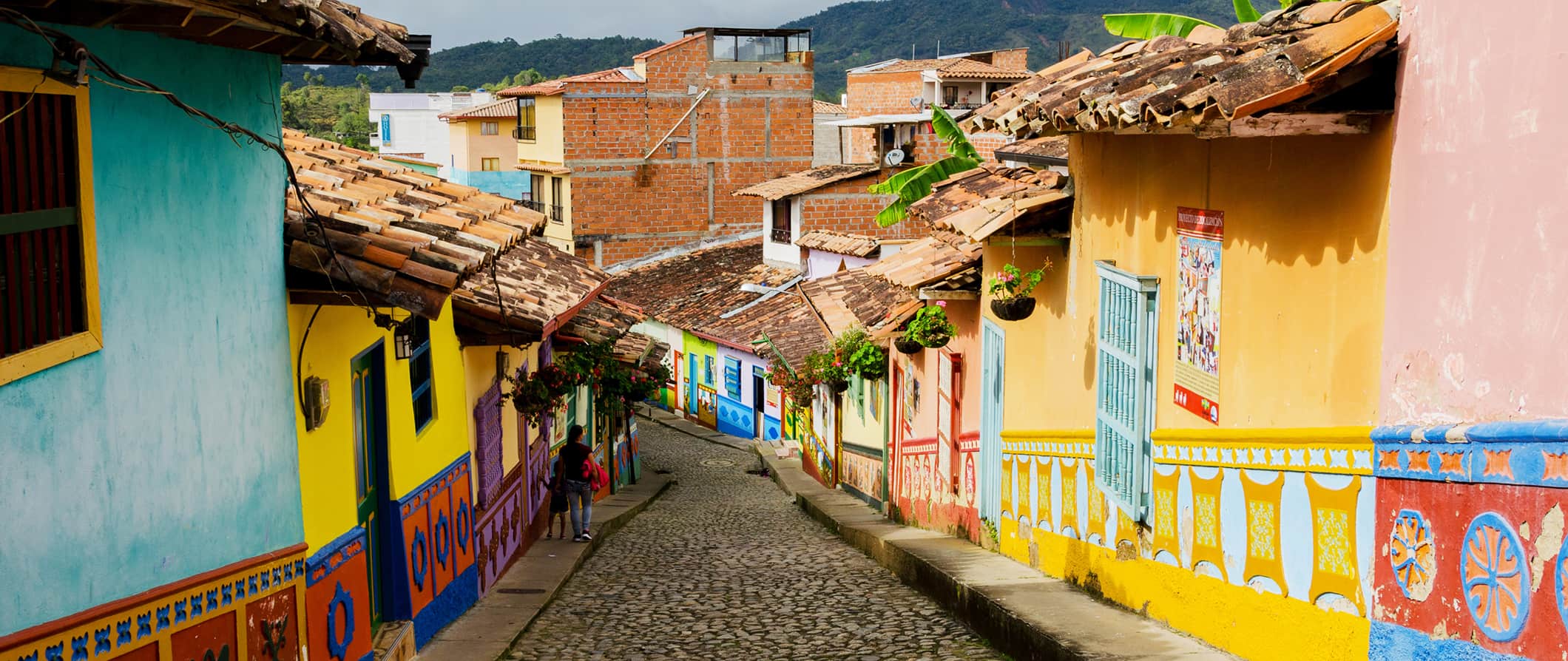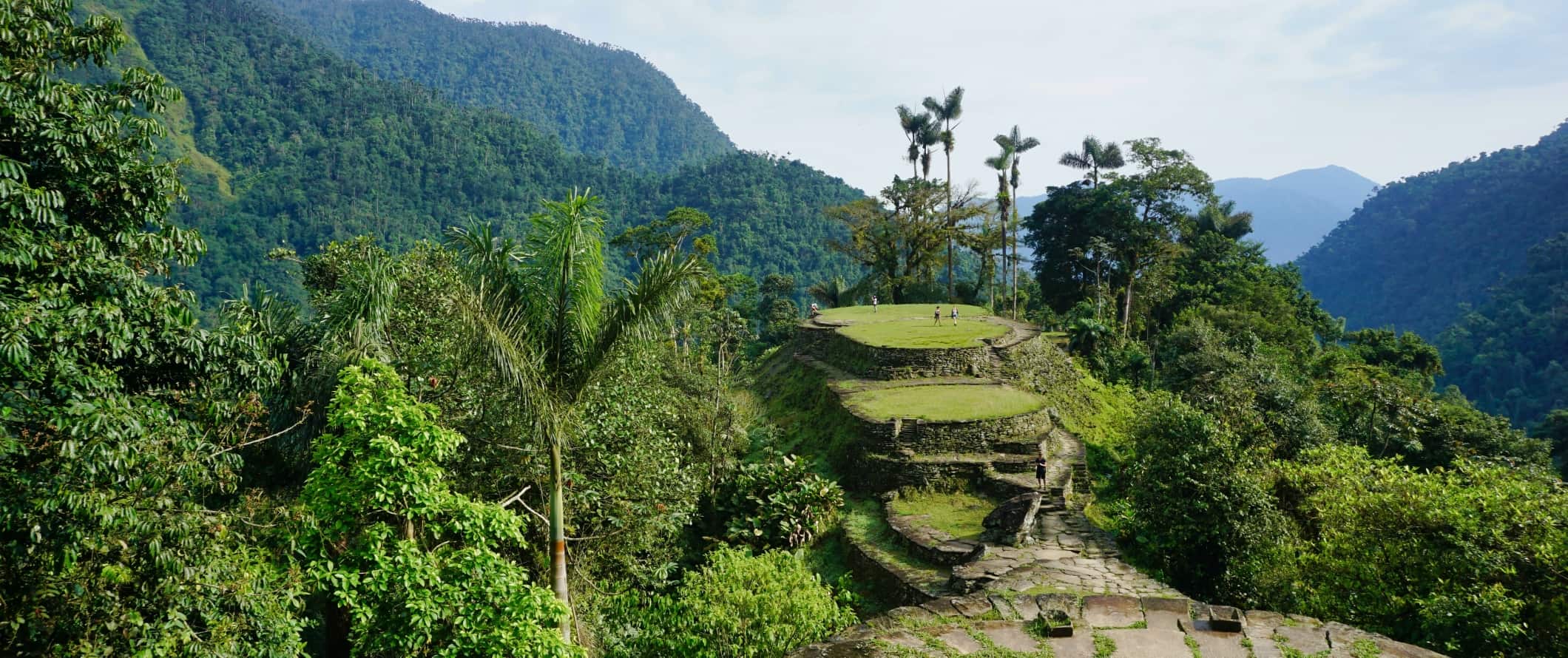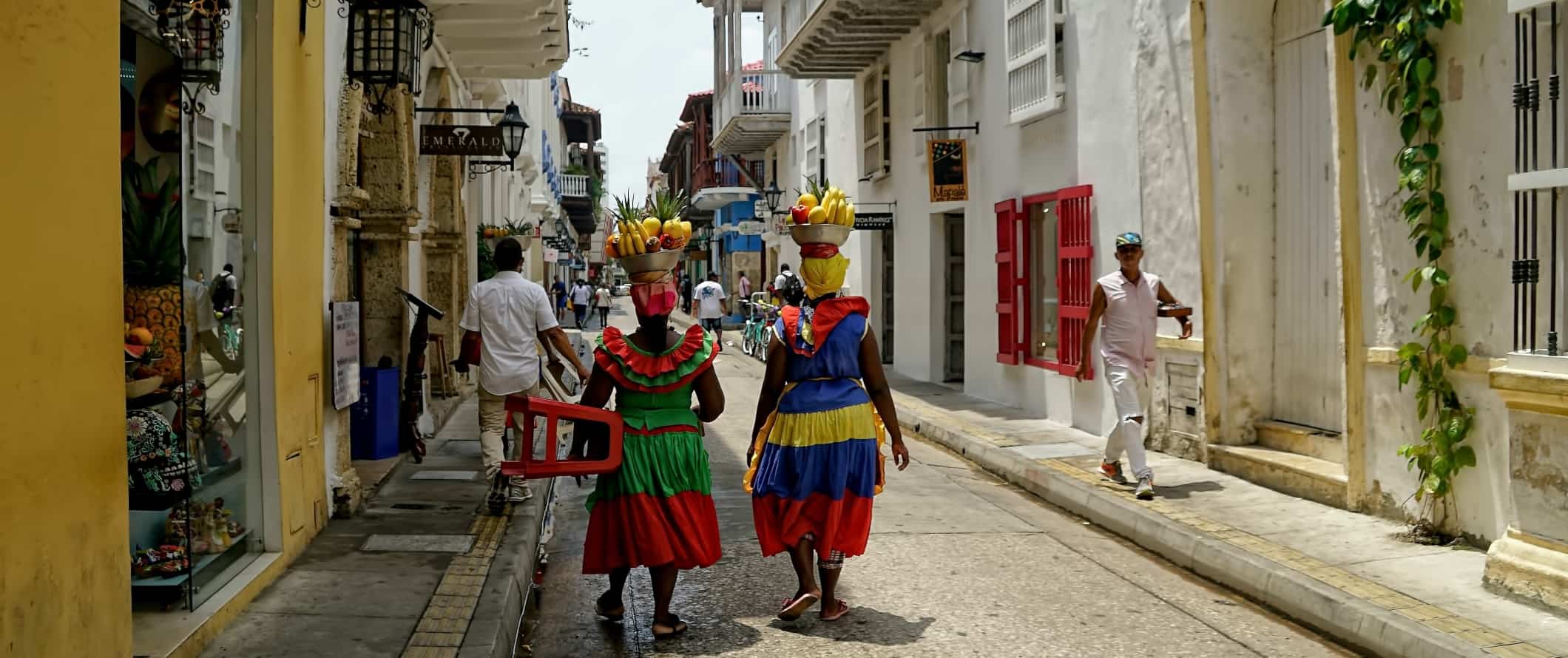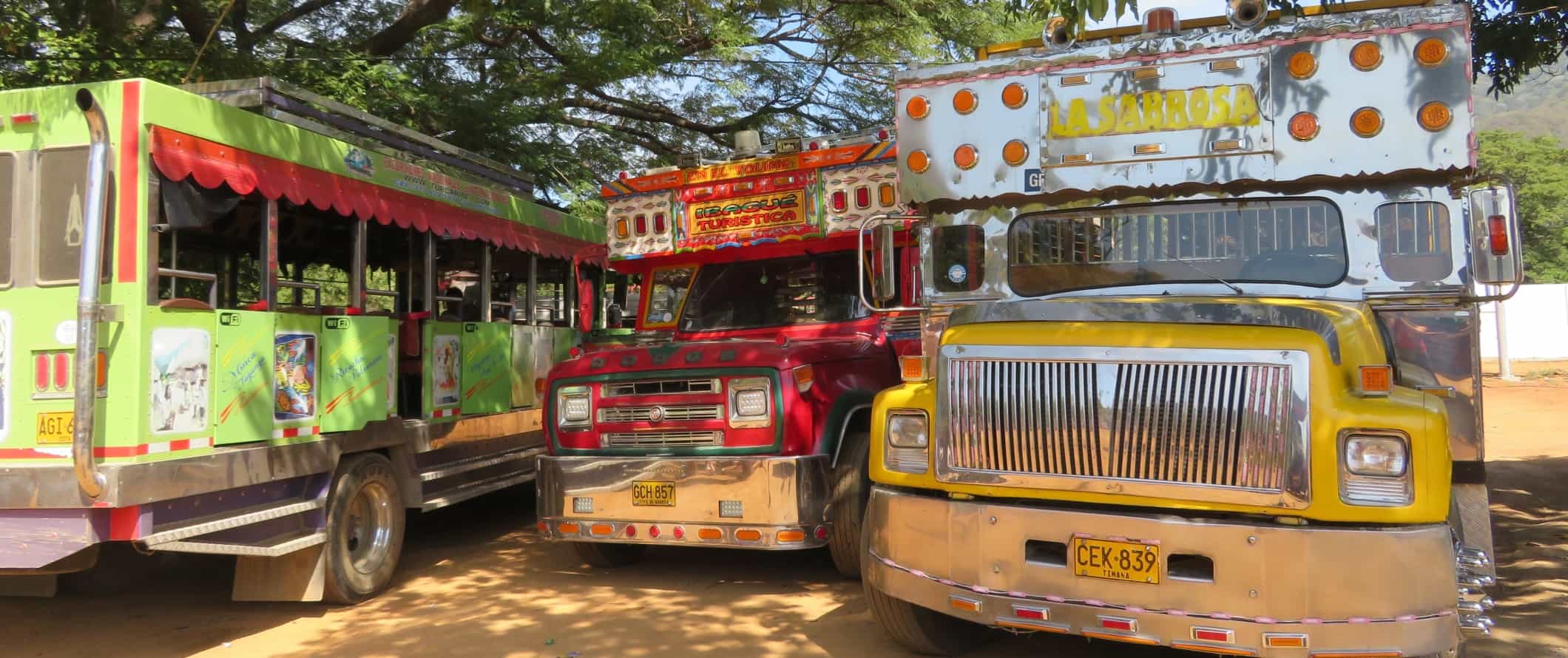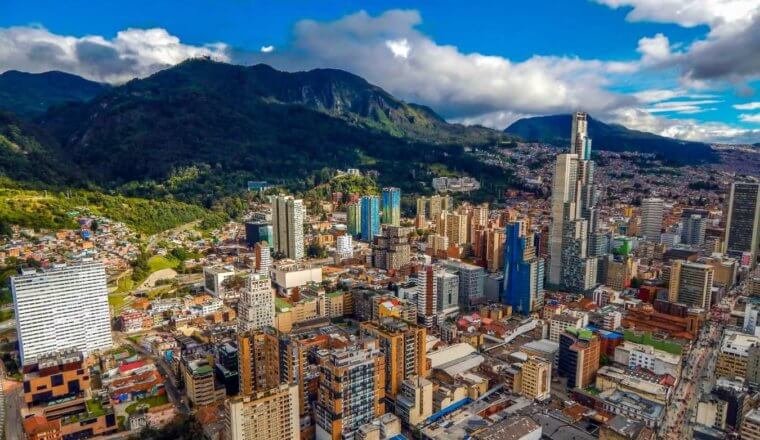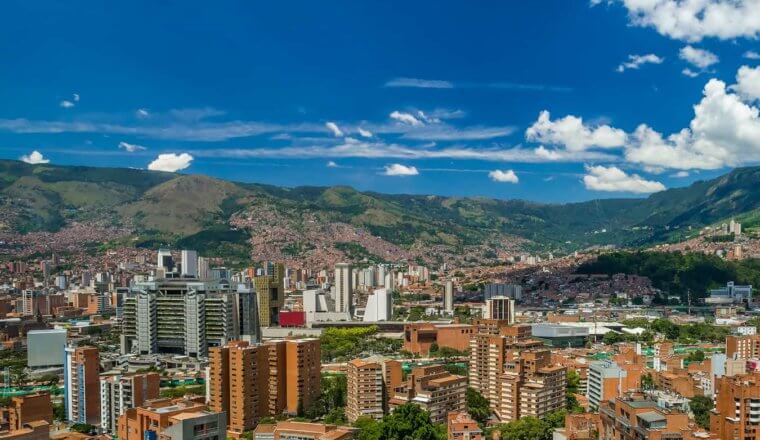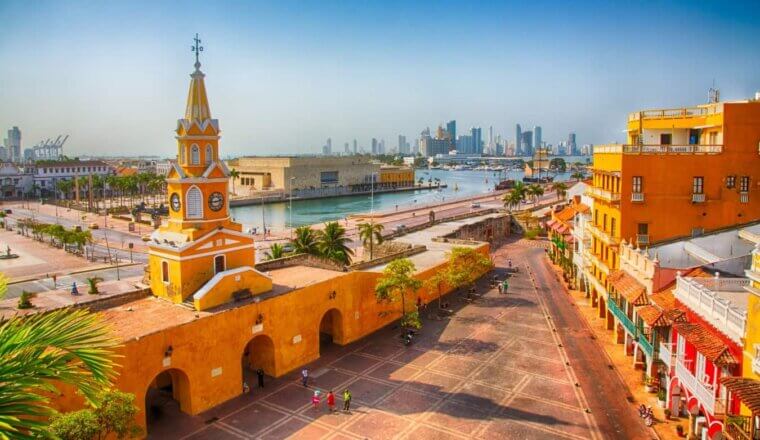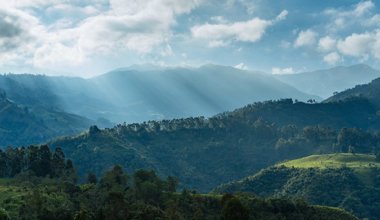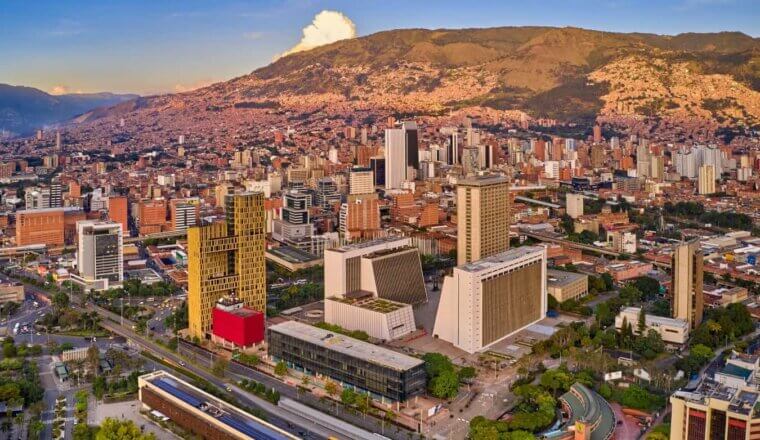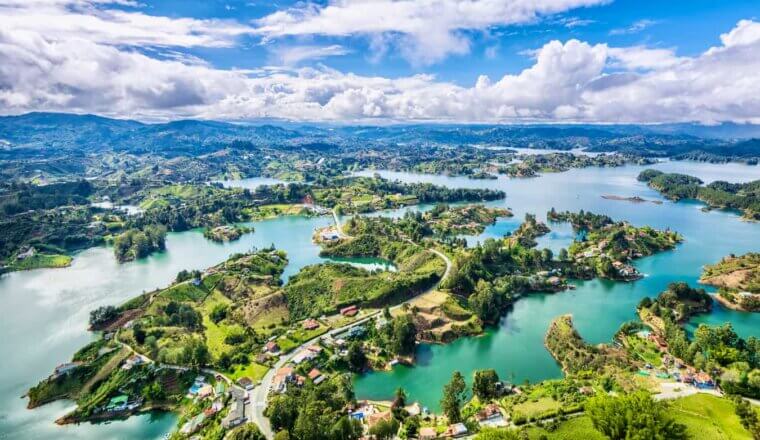Colombia is fast becoming the travel highlight of South America. After decades of struggling with crime and cartels, Colombia has become a hub for digital nomads and budget backpackers. More and more people are visiting to soak up the sun and enjoy the country’s low cost of living.
I loved my time in the country. I had falsely assumed that six weeks would be enough to get a good sense of Colombia. After all, six weeks is a fair amount of time to spend anywhere.
But I was wrong. Given its size and the sheer number of activities, it was barely enough to scratch the surface. (Though I did manage to see a lot more than I thought I would!)
From unbelievable scenery and lush jungles (Colombia is home to 10% of the world’s biodiversity), beautiful beaches, incredible street are, stunning architecture, salsa dancing, delicious food and cutting edge culinary trends, the ancient sites of Tierradentro and San Agustín, hip cities like Medellín and Bogotá, Colombia is a travel paradise
I had such high expectations based on what I heard from other travelers, but the country lived up to all the hype. I wish I had more time there, but I’ll just have to go back!
This comprehensive Colombia travel guide gives you all the tips and tricks you need to plan your dream trip!
Table of Contents
Top 5 Things to See and Do in Colombia
1. Get lost in Bogotá
Bogotá is Colombia’s vibrant capital. The historic downtown, La Candelaria, is filled with bright colonial buildings, museums, restaurants, bars, churches, and centuries-old houses. The foodie scene in the city is incredible, with a lot of international options and cutting-edge gastronomy.
2. Explore Tierradentro National Park
Located in southwestern Colombia, Tierradentro is one of the most important archaeological sites in South America. It contains over 100 underground tombs dating from the 10th century BCE that are the only examples of their kind in the Americas. It takes a day or two to hike all the paths around the tombs.
3. Walk the Cocora Valley
The Cocora Valley is home to Colombia’s national tree, the wax palm, which grows nearly 200 feet tall. This area also has one of the most popular day hikes in the country. You’ll cross jungle rivers, visit a bird sanctuary, and enjoy some stellar views and forest scenery. The route takes about five hours to hike.
4. Fall in love with Medellín
Medellín is one of the fastest-growing cities in Colombia. It has enough activities and things to do to fill weeks on end: microbreweries, museums, walking tours, spacious parks, street art, food tours and markets, incredible nightlife, and more. I loved it so much I spent a few weeks here.
5. Trek to the Lost City
The Lost City was built around 800 CE and contains 169 terraces carved into the mountains. It’s one of the most beautiful treks in the country, and the site is older than Machu Picchu! To visit, you need to hire a tour operator (you can’t do it by yourself). Treks last 4-6 days and cost 1,150,000 COP.
Other Things to See and Do in Colombia
1. Journey to Isla Gorgona
Once a prison island, Isla Gorgona is now part of a national park that lies 48 kilometers (30 miles) off the Pacific coast just southwest of Cali. You’ll see snakes, bats, monkeys, and sloths and the boat journey over also offers some chances to see humpback whales, sharks, and giant sea turtles. The remains of the prison can be seen too. Admission to the park is 51,000 COP per person.
2. Visit San Agustín
A UNESCO World Heritage Site, San Agustín is a small mountain town in the southwest that’s home to hundreds of pre-Columbian statues and burial mounds. Its collection of religious monuments and megalithic sculptures is the largest in Latin America. You need at least one full day (two to see it all in-depth). Admission to the park is 25,000 COP per person.
3. Journey into the Amazon
The Amazon basin covers almost one-third of Colombia and is the perfect place to experience the jungle. Leticia is a town bordering Peru and Brazil and is considered the jumping-off point for jungle excursions and visiting the indigenous villages on the Amazon River. The regions of Guaviare, Putumayo, and Caqueta are also popular for birding, waterfall hikes, and white-water rafting trips. For trekking, most tours involve taking a boat up the river from Leticia and a stop off with an indigenous tribe before arriving at Amacayacu National Park to begin your trek. Prices vary depending on the duration of your trip but expect to pay at least 150,000 COP.
4. Go diving
Colombia is home to some excellent dive sites. The tropical waters around San Andrés and Providencia (both of which are just off the coast of Nicaragua) are home to all kinds of fish and coral species. Tayrona National Park is an ideal place to go if you’re interested in getting up close to some sunken ships, while Gorgona Island is another hotspot for marine life. Humpback whales are common around Gorgona Island between August and October, and it’s also the only place in Colombia to see whale sharks. Expect to pay around 200,000-300,000 COP for a two-tank dive.
5. Learn about coffee
Colombia is home to some of the world’s best coffee, and a tour of a plantation is the best way to find out how your morning brew gets from farm to cup. Salento is the best base for doing coffee tours as it’s one of the oldest towns in the coffee-growing region. The Finca El Ocaso Salento plantation offers one of the most in-depth visits for learning about how the entire process works. Even if you’re not a coffee drinker (I’m not) it’s worth taking a tour to learn about this important industry. Tours start from 25,000 COP.
6. Take in the chaos of Cali
As Colombia’s third-largest city, Cali is the center of the sugar and coffee industry for the country, as well as being host to a terrific nightlife. The city is also the salsa capital of the world and there are tons of places to learn how to salsa dance here. Be sure to also relax in the famous Plaza de los Poetas (Square of the Poets), a park filled with life-like statues of local poets and visit the Iglesia de la Ermita (Ermita Church), one of the city’s most striking pieces of architecture thanks to its 20th-century Gothic design. Eat at the restaurants on Ave 9N in Granada, and try some chuleta valluna (a delicious Colombian dish of breaded and marinated fried pork cutlets).
7. Day trip to Popayán
Popayán rivals Cartagena as Colombia’s most impressive colonial town. It’s known as La Ciudad Blanca (The White City) because all the buildings are painted white. Popayán is also a college town (there are three universities here), and it has produced 17 presidents too. I really loved the slow pace of life and the surprisingly robust food scene here (eat at La Cosecha Parrillada, Restaurante Italiano y Pizzeria, La Fresa, and Mora de Castilla). While you don’t need a lot of time here (take the walking tour, climb the hill, see the churches, and you’re done), I do suggest staying longer to enjoy the slow pace of life. So much of Colombia is go-go-go; it’s nice to find a place that’s more “stay and relax awhile.”
8. Dance and party through Carnival
It may not be Rio de Janeiro, but Colombia has a great Carnival season. Although the Carnival in Barranquilla (which is the largest) takes place in February, Pasto and Manizales offer carnivals in the first week of January. The Carnaval de Blanco y Negro in Manizales is a wild few days of revelry (make sure you bring old black and white clothes if you attend as you’re certain to get doused in flour, paint, and foam!).
9. Do some extreme sports in San Gil
San Gil, located 300 kilometers (186 miles) north of Bogotá, is considered the outdoors capital of the country. Extreme sports fans love it here. You can go white-water rafting, paragliding, caving, rappelling, jungle trekking, and more here. Prices vary but expect to pay around 80,000 COP for paragliding and closer to 200,000 COP for a white-water rafting trip.
10. Relax in Tayrona National Park
Located on Colombia’s Caribbean coast, Tayrona boasts long stretches of golden beaches lined with coconut palms and a dense rainforest with lots of easy day hikes. I highly suggest you start early at the big entrance at El Zaino and exit the park through Calabazo. This underused route takes a whole day, and once you pass the Cabo San Juan campground, you get the last half of the trail to yourself. Tayrona is also home to over 20 dive sites, including shipwrecks and coral reefs, and two-tank dives are as little as 300,000 COP. For some beach time, head to picturesque Cabo San Juan. At the end of the sandy stretch of beach is a lookout point, topped with a hut of hammocks.
11. Head to the Providencia and San Andrés Islands
These islands, which are actually closer to Nicaragua than Colombia, are considered some of the most unspoiled places in the Caribbean. They have white-sand beaches, stunningly clear blue water, and few crowds (though, thanks to some recent press, Providencia is becoming a lot busier). Try to make it when tens of thousands of black crabs migrate to the sea, which happens twice a year for 1-2-weeks between April and July. It’s not always easy to nail the timing but the sight is truly something to see! As mentioned, the region is also perfect for diving.
12. Visit Guatapé
This pueblo is one of the most picturesque towns in Colombia and one of the most colorful in the world as most of the traditional homes have murals painted on the bottom half of their façades that depict animals, people, and shapes. Most people come to climb the steep (and difficult) staircase to the top of the monolithic Rock of Guatapé (La Piedra) for some of the best views in the country. Guatapé is a long day trip from Medellín (hostels in the city organize them throughout the week), so I recommend trying to spend at least a night here so you aren’t as rushed and can enjoy the area a little more.
13. Hike in Chingaza National Park
This is one of the biggest nature reserves in Colombia, home to more than 1,000 plant species and 187 bird species. Here you can learn about the Páramo ecosystem (an alpine tundra ecosystem) and how it affects the global water system. (Fun fact: Nearly 80% of Bogotá’s water supply comes from Chingaza.) If you’re going to hike, one of the best routes is the challenging hike to the summit of Lagunas de Siecha.
14. Hike in Minca
Minca is located in the foothills of the Sierra de Santa Marta Mountains. Once a sleepy backpacker town, it’s now a hot spot for tourists escaping the oppressive heat on the Caribbean coast who want to do some quiet hikes. One of the best hikes here is to Los Pinos, but it isn’t easy and takes 6-8 hours (though it’s worth the effort). Just make sure you bring lots of water and start early so you don’t get stuck in the dark.
15. Visit Cartagena
Cartagena is one of the most visited destinations in Colombia, thanks to a lot of direct flights and cruise ship visits. The city was founded by the Spanish in 1533 (though there were indigenous settlements in the area as far back as 4,000 BCE) It’s famed for its Old Town, a maze of cobbled alleys, flower-covered balconies, and large churches on spacious plazas. Despite the crowds (and there are a lot of crowds), I really enjoyed Cartagena. While there aren’t a lot of tourist activities (you can do most of them in a single day), what makes it a wonderful place to visit is just that: it’s somewhere you can slow down, relax, and gorge on the phenomenal food!
16. Take a free walking tour
One of the first things I do when I arrive in a new city is to take a free walking tour. It’s the best way to see the highlights and connect with a local guide who can answer all your questions. All the major cities have free walking tours in English that provide a solid introduction to the country. Just make sure to tip your guide at the end!
For information on specific destinations in Colombia, check out these guides:
Colombia Travel Costs
Accommodation – Most hostel dorm rooms in Colombia cost 30,000-45,000 COP per night, though in some cities and towns you can find them as low 15,000 COP. Private hostel rooms cost around 40,000 COP, though during the high season and in major metropolitan areas, it can be double that or even more. Free Wi-Fi and self-catering facilities are common, and many hostels also include breakfast.
Budget hotels in Colombia cost around 60,000 COP per night. On the coast and in the high season, however, most places are closer to around 120,000 COP. If you’re looking to stay at some of the really lovely boutique hotels the country has to offer, expect to pay around 650,000 COP or more a night.
Airbnb is available in the larger cities, with private rooms starting around 50,000 COP per night but going as high as 150,000 COP if you don’t book early. For an entire home or apartment, prices start at 150,000 COP but average closer to 280,000 COP.
There aren’t many campgrounds in Colombia, but hostels and guesthouses sometimes let you pitch a tent on their property. They charge you as much as a dorm bed though. Avoid wild camping here as it isn’t very safe.
Food – Colombian food is a blend of indigenous, Caribbean, and European traditions. While ingredients and popular dishes vary by region, common staples include maize, potato, cassava, rice, and all kinds of tropical fruit (dragon fruit, papaya, guava, passionfruit). Fried plantains, chicken soup, tamales, empanadas, meat pies, and roasted piglet are just some of the delicious popular dishes you’ll encounter.
A meal at a restaurant serving local food costs between 10,000-15,000 COP in the major cities and about 6,000-10,000 COP in the countryside. You can also find a lot of cheap food like empanadas for 2,500 COP (they make the best snack food). An arepa on the street is about 3,000-5,000 COP. Ceviche, which is popular throughout the country, costs around 15,000 COP.
Most Western restaurants cost 20,000-30,000 COP for a main dish. For fast food (think McDonald’s), expect to pay 15,000-20,000 COP for a combo meal.
Beer at the bar can be found for as little as 4,000 COP but you’re likely to pay double at a backpacker bar. Cocktails, which are becoming really popular here, cost around 20,000 COP.
Grocery shopping is very cheap, costing about 80,000-100,000 COP per week for staples like rice, beans, produce, and some meat or seafood. Most hostels have kitchens so you can make yourself breakfast and sandwiches to lower your food costs.
Activities – Museums usually cost around 5,000 COP. Coffee tours are 25,000 COP while a two-tank dive is around 300,000 COP. Admission to parks and nature reserves is usually 25,000-50,000 COP. Paragliding costs around 80,000 COP while white-water rafting is closer to 200,000 COP. A 4-6-day hike to the Lost City costs 1,150,000 COP.
Backpacking Colombia Suggested Budgets
If you are backpacking Colombia, my suggested budget is 115,000 COP per day. This assumes you’re staying in a hostel dorm, cooking some meals and eating cheap street food, taking public transportation to get around, limiting your drinking, and sticking to mostly free or cheap activities like free walking tours and enjoying nature.
On a mid-range budget of 235,000 COP per day, you can stay in a budget hotel or private Airbnb, eat out for all your meals, enjoy a few drinks, take some guided tours, take a couple of cheap domestic flights, and do more paid activities like visiting museums and taking a food tour.
On a “luxury” budget of 500,000 COP per day, you can stay in a hotel, eat out anywhere you want, drink more, take more domestic flights, and do whatever tours and activities you want. This is just the ground floor for luxury though. The sky is the limit!
Colombia Travel Guide: Money-Saving Tips
Colombia is generally an inexpensive destination to visit. Accommodation is cheap unless you are staying at major hotel chains. There are a ton of markets with cheap food, local attractions are affordable, and buses are cheap. But if you want to save even more, here are some extra ways to save money in Colombia:
- Eat like the locals – It’s easy to eat on a budget here if you stick to local Colombian food. Street food is super cheap, allowing you to fill up on a budget. Skip the fancy restaurants and Western food.
- Avoid drinking cocktails – Colombia has a lot of awesome cocktail bars now — especially in Medellín — but these drinks are expensive, usually costing around 20,000 COP (sometimes up to 30,000 COP). If you’re on a budget, skip the cocktails and stick to beer.
- Cook your food – While local food is really cheap, you can also save some money by grocery shopping. It’s not as glamorous but shopping for some of your meals will help you cut costs so you can afford to eat out more here and there.
- Avoid the hostels on the Caribbean coast – The hostels on the Caribbean coast were pretty lackluster. They were expensive and didn’t have great facilities, especially the bigger “resort” ones in beachside towns like Palomino. Instead, you can find comparatively cheap budget hotels on Booking.com for less than a private room in a hostel (and only slightly more than a dorm bed).
- Avoid “Gringolands” – Everything where the gringos cluster are is going to be double its normal price. Avoid staying in areas with lots of tourists and expats (like Poblado in Medellín, Cartagena’s Old Town, or Park 93 in Bogotá) since you’ll end up paying more for everything.
- Stay with a local – Couchsurfing connects you with locals who not only give you a free place to stay but can share their insider tips and advice. It’s the best way to save money and connect with a local.
- Fly Viva Air – If you’re planning to fly around Colombia, the best deals are on Viva Air. It has the cheapest fares in the country (though it flies to the fewest places). It’s best to book a few weeks in advance. (LATAM and Avianca, the two major carriers, also have deals sometimes so check their websites too.)
- Use miles and points – Get to Colombia by using your miles to fly Avianca (which is part of Star Alliance). There are also a lot of hotel chains in Colombia where you can use points too. If you have miles and/or points, you can burn through a lot of them in Colombia — and the redemption rates are excellent! And if you want to learn how to start earning miles for free travel, this post can show you how to get started!
- Avoid the airline surcharge – Non-Colombians are charged higher airfare prices than locals. If you look at the non-local version of the website, you won’t see the super saver cheap fares. To get around this, load up the local Spanish versions of an airlines’ website. Then use your browser extension to translate the pages and book away! This gives you the lower, Colombian prices, and no one will challenge you at check-in about your fare.
- Take Uber – Uber is the cheapest way to get around Bogotá, Cali, and Medellín. That said, Uber is actually illegal so don’t sit in the back seat or you might get stopped. I also like to tip the Uber drivers here, since the fares are so cheap and they are taking a risk. But all the drivers I met did this out of necessity — they couldn’t pay their bills if it weren’t for Uber.
- Haggle with taxi drivers – There are no meters in Colombia. While prices from the airports are regulated and non-negotiable, everything else is just a matter of your bargaining skills. If you’re going to take taxis, haggle before you get in the car.
- Take free walking tours – Most major and medium-sized cities in Colombia have free walking tours. They are a good way to see the city on a budget and connect with a guide who can answer all your questions. My favorites include Free Walking Tour Cartagena, Free Walking Tour Bogotá, and Real City Tours Medellín.
- Pack a water bottle – The tap water here is generally safe to drink so bring a water bottle with you to avoid buying single-use plastic. My preferred bottle is LifeStraw, which has built-in filters to ensure your water is always clean and safe.
Where to Stay in Colombia
Looking for a budget-friendly place to stay? Here are some of my favorite accommodations in Colombia:
- Media Luna (Cartagena)
- Republica Hostel Cartagena (Cartagena)
- Los Patios Hostel Boutique (Medellín)
- Hostel Rango Boutique
- Sugar Cane Hostel (Medellín)
- Selina (Bogotá)
- The Cranky Croc Hostel (Bogotá)
- La Brisa Loca (Santa Marta)
- Dreamer Santa Marta (Santa Marta)
- Hostel Masaya Santa Marta (Santa Marta)
- Viajero Cali Hostel & Salsa School (Cali)
- Oasis Cali Hostel (Cali)
How to Get Around Colombia
Public Transportation – Local transportation is cheap here. The metro in Medellín is only around 2,500 COP for a one-way fare. Local buses are the most common type of transportation in towns and cities. The fare is usually between 1,000-2,500 COP.
Colectivo – A colectivo in Colombia is a minibus, a shared taxi, or a large Jeep (and really, anything else that gets you around). These are run by private owners and are used mostly for short journeys between towns. You have to negotiate the price ahead of time. Since they’re faster and more direct than regular buses, they’re also more expensive.
It’s very common for travelers to use a colectivo. Drivers usually yell out destinations as they pass on the streets, or they approach you to see if you’re going their way.
Bus – Intercity buses are the most common way to get around Colombia. A bus from Bogotá to Medellín costs around 52,500 and takes around 9 hours while a bus to Quito, Ecuador from Bogotá costs around 181,000 COP and takes over 24 hours. Medellín to Manizales is 31,000 COP and Salento to Cali is 59,000 COP. On average, expect to spend 20,000-40,000 COP for a bus.
Companies like Expreso Palmira and Expreso Trejos are reliable companies, and they make it easy to research schedules and fares on their websites.
Flying – Budget airlines are often cheaper than buses in Colombia, so make sure to search for flights to compare prices. Viva has the cheapest flights (though they also have strict luggage restrictions). A flight from Bogotá to Medellín, for example, can be found for as little as 55,000 COP! Book early to find the best deals.
Train – There are no trains in Colombia.
Car rental – Cars can be rented for as little as 90,000 COP per day, though you don’t need one to get around the cities. Additionally, since break-ins are common I’d avoid renting a car unless you’re doing a specific trip beyond the cities. Drivers need to be at least 21 and have an International Driving Permit.
Hitchhike – Do not hitchhike in Colombia. It’s not safe.
When to Go to Colombia
Colombia’s location near the equator keeps the climate pretty consistent throughout the year, with average daily temperatures hovering around 24°C (75°F) near the coast and 7-17°C (45-63°F) at higher elevations.
The peak season for tourism is from December to March, as well as the week before Easter (Semana Santa). Prices are most expensive during this time, but the country overall is fairly dry. If you’ve come to have fun, time your visit for the Carnival in Barranquilla, which takes place every February. This is the biggest Carnival, but Pasto and Manizales also have lively carnivals in the first week of January.
The rainy season varies per region. In the mountainous Andean area, there are two dry and two wet seasons. The driest months occur from December-March and then July-August. In Southern Colombia, rainfall is more frequent, but the showers never last long.
If you’re planning on doing a bit of everything in Colombia — from hiking in the mountains to lounging on beaches and visiting ruins — December to March is definitely the best time to visit so you can take advantage of ideal conditions all across the country. Just be prepared for bigger crowds.
How to Stay Safe in Colombia
Colombia requires a lot of caution. On the whole, it’s generally safe and you’re not going to get kidnapped or anything. But there is still a lot of petty crime in the country, especially at night.
In fact, there’s a local expression about this in Colombia: “No dar papaya” (Don’t give papaya). Essentially, it means that you shouldn’t have something “sweet” out in the open (a phone, computer, watch, etc.) that would make you a target. Keep your valuables hidden, don’t wander around places you shouldn’t at night, don’t flash money around, avoid coming out of nightlife spots alone at night, etc.
Simply put: Don’t put yourself in a position where people can take advantage of you.
Do not do drugs here. You’re going to get a lot of offers but don’t be one of those people. First, it’s a huge insult to Colombians, who are trying to shed their drug-related past and don’t want to be associated with the cartels. Second, it’s illegal (although small amounts of cocaine and marijuana are decriminalized). Third, there’s a lot of violence associated with it, and you can end up in some bad situations. Don’t do drugs here.
You should also use caution when withdrawing money from an ATM. Avoid the ATMs on the street if possible and go into the bank to use the ATM. That way you can put your money away discreetly without being watched.
If you are eating out, keep your backpack on your lap or place your foot or a chair leg through a strap. It is very common for someone to try and snatch your bag so keep it secure at all times.
If you’re worried about getting ripped off you can read about common travel scams to avoid here. There’s a lot so keep an eye out!
Look for hotels or hostels with 24-hour security. You always want someone around in case you need assistance.
Always trust your gut instinct. Make copies of your personal documents, including your passport and ID. Forward your itinerary along to loved ones so they’ll know where you are.
If you experience an emergency and need assistance, dial 123.
Because of the current situation in Venezuela, it’s a good idea to avoid the border towns of Cúcuta and Maicao.
For more in-depth coverage of how to stay safe in Colombia, check out this post we wrote that answers some frequently asked questions and concerns.
The most important piece of advice I can offer is to purchase good travel insurance. Travel insurance protects you against illness, injury, theft, and cancellations. It’s comprehensive protection in case anything goes wrong. I never go on a trip without it as I’ve had to use it many times in the past. You can use the widget below to find the policy right for you:
Colombia Travel Guide: The Best Booking Resources
These are my favorite companies to use when I travel. They consistently have the best deals, offer world-class customer service and great value, and overall, are better than their competitors. They are the companies I use the most and are always the starting point in my search for travel deals.
- Skyscanner – Skyscanner is my favorite flight search engine. They search small websites and budget airlines that larger search sites tend to miss. They are hands down the number one place to start.
- Hostelworld – This is the best hostel accommodation site out there with the largest inventory, best search interface, and widest availability.
- Booking.com – The best all around booking site that constantly provides the cheapest and lowest rates. They have the widest selection of budget accommodation. In all my tests, they’ve always had the cheapest rates out of all the booking websites.
- Get Your Guide – Get Your Guide is a huge online marketplace for tours and excursions. They have tons of tour options available in cities all around the world, including everything from cooking classes, walking tours, street art lessons, and more!
- SafetyWing – Safety Wing offers convenient and affordable plans tailored to digital nomads and long-term travelers. They have cheap monthly plans, great customer service, and an easy-to-use claims process that makes it perfect for those on the road.
- LifeStraw – My go-to company for reusable water bottles with built-in filters so you can ensure your drinking water is always clean and safe.
- Unbound Merino – They make lightweight, durable, easy-to-clean travel clothing.
- Top Travel Credit Cards – Points are the best way to cut down travel expenses. Here’s my favorite point earning credit cards so you can get free travel!
Colombia Travel Guide: Related Articles
Want more info? Check out all the articles I’ve written on Colombia travel and continue planning your trip:
Where to Stay in Bogotá: The Best Neighborhoods for Your Visit
Where to Stay in Medellín: The Best Neighborhoods for Your Visit
Is Colombia Safe to Visit?
How Much Does it Cost to Travel Colombia?
14 Things to Do in Medellín (and the ONE thing NOT to do!)
My 21 Favorite Places to Visit in Colombia
